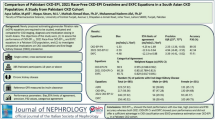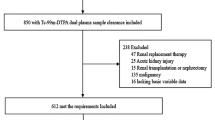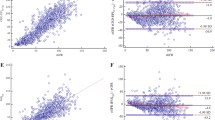Abstract
Background
Our previous studies demonstrated that 2012 Chronic Kidney Disease Epidemiology Collaboration (CKD-EPI) equations were inaccurate enough for estimating glomerular filtration rate in elderly Chinese. Thus, this study was constructed to modify these equations.
Methods
A total of 839 subjects (aged ≥60 years) from four hospitals in China between October 2009 and December 2014 were included. A random sample of 674 (80.3 %) subjects was used as a training sample set, and the remaining 165 (19.7 %) subjects as the verification set. The equations were modified using the hill-climbing algorithm.
Results
Compared with the original CKD-EPI equations, the accuracy assessment indexes (bias, precision, accuracy and misclassification) were obviously improved after modification. Bland–Altman analysis also demonstrated that this modification attempt gained success to some extent.
Conclusions
The modified 2012 CKD-EPI equations could be more accurate than the original equations for elderly Chinese individuals.

Similar content being viewed by others
References
Stenvinkel P (2010) Chronic kidney disease: a public health priority and harbinger of premature cardiovascular disease. J Intern Med 268(5):456–467
Zhang L, Wang F, Wang L et al (2012) Prevalence of chronic kidney disease in China: a cross-sectional survey. Lancet 379(9818):815–822
Stevens LA, Padala S, Levey AS (2010) Advances in glomerular filtration rate-estimating equations. Curr Opin Nephrol Hypertens 19(3):298–307
Perrone RD, Madias NE, Levey AS (1992) Serum creatinine as an index of renal function: new insights into old concepts. Clin Chem 38(10):1933–1953
Liu X, Cheng MH, Shi CG et al (2012) Variability of glomerular filtration rate estimation equations in elderly Chinese patients with chronic kidney disease. Clin Interv Aging 7:409–415
Xun L, Cheng W, Hua T et al (2010) Assessing glomerular filtration rate (GFR) in elderly Chinese patients with chronic kidney disease (CKD): a comparison of various predictive equations. Arch Gerontol Geriatr 51(1):13–20
Zhu Y, Ye X, Zhu B et al (2014) Comparisons between the 2012 new CKD-EPI (Chronic Kidney Disease Epidemiology Collaboration) equations and other four approved equations. PLoS One 9(1):e84688
Pei X, Yang W, Wang S et al (2013) Using mathematical algorithms to modify glomerular filtration rate estimation equations. PLoS One 8(3):e57852
Levey AS, Coresh J, Greene T et al (2007) Expressing the modification of diet in renal disease study equation for estimating glomerular filtration rate with standardized serum creatinine values. Clin Chem 53(4):766–772
Rehling M, Moller ML, Thamdrup B, Lund JO, Trap-Jensen J (1984) Simultaneous measurement of renal clearance and plasma clearance of 99mTc-labelled diethylenetriaminepenta-acetate, 51Cr-labelled ethylenediaminetetra-acetate and inulin in man. Clin Sci (Lond) 66(5):613–619
Inker LA, Schmid CH, Tighiouart H et al (2012) Estimating glomerular filtration rate from serum creatinine and cystatin C. N Engl J Med 367(1):20–29
National Kidney Foundation (2002) K/DOQI clinical practice guidelines for chronic kidney disease: evaluation, classification, and stratification. Am J Kidney Dis 39(2 Suppl 1): S1–S266
Guo X, Qin Y, Zheng K et al (2014) Improved glomerular filtration rate estimation using new equations combined with standardized cystatin C and creatinine in Chinese adult chronic kidney disease patients. Clin Biochem 47(13–14):1220–1226
Wei L, Ye X, Pei X, Wu J, Zhao W (2014) Reference intervals for serum cystatin C and factors influencing cystatin C levels other than renal function in the elderly. PLoS One 9(1):e86066
Tangri N, Stevens LA, Schmid CH et al (2011) Changes in dietary protein intake has no effect on serum cystatin C levels independent of the glomerular filtration rate. Kidney Int 79(4):471–477
Vinge E, Lindergard B, Nilsson-Ehle P, Grubb A (1999) Relationships among serum cystatin C, serum creatinine, lean tissue mass and glomerular filtration rate in healthy adults. Scand J Clin Lab Investig 59(8):587–592
Inker LA, Astor BC, Fox CH et al (2014) KDOQI US commentary on the 2012 KDIGO clinical practice guideline for the evaluation and management of CKD. Am J Kidney Dis 63(5):713–735
Acknowledgments
This work was supported by the grants from the Major State Basic Research Development Program of China 2013CB530803, the National Natural Science Foundation of China H0511-81370843, the Chinese Medical Association of Clinical Medicine Research Special Funds 15020020590, the Innovation of Science and Technology Achievement Transformation Fund of Jiangsu Province BL2012066 and a Project Funded by the Priority Academic Program Development of Jiangsu Higher Education Institutions JX10231801.
Author information
Authors and Affiliations
Corresponding author
Ethics declarations
Conflict of interest
The authors declare that they have no conflict of interest.
Ethical approval
The study was approved by the ethics committee of The First Affiliated Hospital of Nanjing Medical University and conducted in accordance with the Declaration of Helsinki.
Additional information
Fen Li and Xiaohua Pei have contributed equally to this work.
Rights and permissions
About this article
Cite this article
Li, F., Pei, X., Ye, X. et al. Modification of the 2012 CKD-EPI equations for the elderly Chinese. Int Urol Nephrol 49, 467–473 (2017). https://doi.org/10.1007/s11255-016-1434-5
Received:
Accepted:
Published:
Issue Date:
DOI: https://doi.org/10.1007/s11255-016-1434-5




